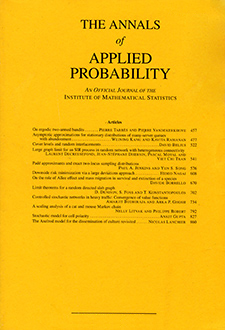Abstract
The move-to-root heuristic is a self-organizing rule that attempts to keep a binary search tree in near-optimal form. It is a tree analogue of the move-to-front scheme (also known as the weighted random-to-top card shuffle or Tsetlin library) for self-organizing lists. We study convergence of the move-to-root Markov chain to its stationary distribution and show that move-to-root converges two to four times faster than move-to-front for many examples. We also discuss asymptotics for expected search cost. For equal weights, $\operatorname{cn}/\ln n$ steps are necessary and sufficient to drive the maximum relative error to 0.
Citation
Robert P. Dobrow. James Allen Fill. "Rates of Convergence for the Move-to-Root Markov Chain for Binary Search Trees." Ann. Appl. Probab. 5 (1) 20 - 36, February, 1995. https://doi.org/10.1214/aoap/1177004825
Information





